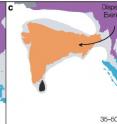Land bridges linking ancient India and Eurasia were 'freeways' for biodiversity exchange
Related images
(click to enlarge)
For about 60 million years during the Eocene epoch, the Indian subcontinent was a huge island. Having broken off from the ancient continent of Gondwanaland, the Indian Tectonic Plate drifted toward Eurasia. During that gradual voyage, the subcontinent saw a blossoming of exceptional wildlife, and when the trove of unique biodiversity finally made contact with bigger Eurasia, the exchange of animals and plants between these areas laid the foundations for countless modern species.
"Today, mainland Asia and India have all this unique biodiversity -- but did the mainland Asian biodiversity come from India, or did the Indian biodiversity come from other regions of Asia?" asked Jesse Grismer, doctoral candidate with the Biodiversity Institute at the University of Kansas.
Grismer claims the answer depends on the organism in question.
"If you picked Asian freshwater crabs, you'd see they started in India and made their way to Asia, but if you picked dragon lizards you'd get the opposite answer," he said. "The opposing distribution patterns created a lot of conflict for a while. You'd see papers saying, 'Everything came from India,' and others saying, 'No, everything came from Indochina and Southeast Asia.' But they were looking at opposite ends of the same pattern, just with different animals."
Now, Grismer has authored research appearing in the journal BMC Evolutionary Biology showing that before the final collision of Eurasia and the Indian subcontinent, land bridges between the landmasses may have served as "freeways" of biodiversity exchange that flowed in both directions.
"Our paper shows that as India was approaching Eurasia, it was connecting by ephemeral land bridges," Grismer said. "It was these land bridges that allowed for dispersal and exchange of all these species. There were two areas of suitable habitat separated by unsuitable oceans. But once that new area was exposed, species were allowed to disperse into mainland Asia or India, respectively, areas that these species had not been able to previously exploit."
To arrive at their conclusion, Grismer and his co-authors performed a phylogenomic analysis of Indian Dragon Lizards, revealing multiple origins in Southeast Asia. The researchers included Alana Alexander, Phillip Wagner, Scott L. Travers, Matt D. Buehler, Luke J. Welton and Rafe M. Brown from KU and James A. Schulte II from Clarkson University. Grismer also credits his KU lab mates Chan Kin Onn, Robin Abraham and Carl Hutter with help on the research via "a lot of fruitful discussion."
Importantly, the team showed that two land bridges connected the Indian subcontinent to Eurasia at two different times during the early to middle Eocene, some 35 to 40 million years ago.
"This hypothesis is based on evolutionary relationships between the species used in this study," he said. Grismer added that his team blended new genomic data with previous studies and combined that analysis with new geologic studies about Eocene geology.
The KU researcher said Indian Dragon Lizards, or the Draconinae subfamily of the lizard family Agamidae, are an ideal species to study in order to piece together a picture of the exchange of biodiversity that took place due to the land bridges.
"Dragon lizards added new light because of the previous work that has been done on them, plus our new samples," Grismer said. "They're quite diverse as a group, distributed equally, and so they're great study system for testing a new hypotheses."
He added that conservation of certain species of Dragon Lizards and keeping them out of the international pet trade would help make possible more opportunities for understanding the history of this unique group of family of lizards.
"We were only able to do this because we had all these species to work with, and a future study with more data and new species could find a new result to this question " he said. "Animals in general tell us a lot about our world and how we fit into it. I think protecting them is just as important as anything else we do."
Source: University of Kansas
Other sources
- Land bridges linking ancient India, Eurasia were 'freeways' for biodiversity exchangefrom Science DailyFri, 25 Mar 2016, 0:10:42 UTC
- Land Bridges Linking Ancient India and Eurasia Were 'Freeways' for Biodiversity Exchangefrom Newswise - ScinewsThu, 24 Mar 2016, 18:40:40 UTC
- Land bridges linking ancient India and Eurasia were 'freeways' for biodiversity exchangefrom PhysorgThu, 24 Mar 2016, 18:30:58 UTC

